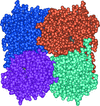issue contents
April 2011 issue
From crystal to structure with CCP4
Proceedings of the CCP4 study weekend

Cover illustration: Human Thr160-phospho-CDK2-cyclin A complexed with a bis-anilino-pyrimidine inhibitor, PDB entry 2iw6. Drawn using CCP4mg (p. 386).
research papers
Open  access
access
 access
accessAn overview of the CCP4 software suite for macromolecular crystallography is given.
Open  access
access
 access
accessProtein surface engineering is increasingly used as a routine tool to enhance the crystallization propensity of proteins. Future possibilities include the use of multi-site protein variants, rational modulation of solubility and the development of strategies to tackle membrane proteins.
Open  access
access
 access
accessThe Protein Information Management System (PiMS) is described together with a discussion of how its features make it well suited to laboratories of all sizes.
Open  access
access
 access
accessThoughts about the decisions made in designing macromolecular X-ray crystallography experiments at synchrotron beamlines are presented.
Open  access
access
 access
accessA new graphical user interface to the MOSFLM program has been developed to simplify the processing of macromolecular diffraction data. The interface, iMOSFLM, allows data processing via a series of clearly defined tasks and provides visual feedback on the progress of each stage.
Open  access
access
 access
accessA summary of how to run the data-reduction programs in the CCP4 suite.
Open  access
access
 access
accessTypical topics and problems encountered during data processing of diffraction experiments are discussed and the tools provided in the autoPROC software are described.
Open  access
access
 access
accessThe molecular-replacement model-improvement program Sculptor is described, with an analysis of the algorithms used.
Open  access
access
 access
accessThe automated pipelines for molecular replacement MrBUMP and BALBES are reviewed, with an emphasis on understanding their output. Conclusions are drawn from their performance in extensive trials.
Open  access
access
 access
accessSome future challenges for the PDB and its guardians are discussed and current and future activities in structural bioinformatics at the Protein Data Bank in Europe (PDBe) are described.
Open  access
access
 access
accessRecent developments in the CRANK software suite for experimental phasing have led to many more structures being built automatically.
Open  access
access
 access
accessSAD data can be used in Phaser to solve novel structures, supplement molecular-replacement phase information or identify anomalous scatterers from a final refined model.
Open  access
access
 access
accessA cross-validation-based method for bias reduction in `classical' iterative density modification of experimental X-ray crystallography maps provides significantly more accurate phase-quality estimates and leads to improved automated model building.
Open  access
access
 access
accessThe general principles behind the macromolecular crystal structure refinement program REFMAC5 are described.
Open  access
access
 access
accessThe software suite Xsolve semi-exhaustively explores key parameters of the X-ray structure-determination process to compute multiple three-dimensional protein structures independently and in parallel from a set of diffraction images. An optimal consensus model for subsequent manual refinement is computed from these structures.
Open  access
access
 access
accessMethods for the analysis of the relationship between macromolecular complexes and interactions and their manifestation in crystal packing are described and discussed.
Open  access
access
 access
accessThe CCP4 molecular-graphics program now uses the Qt framework to provide a modern look and feel. There are many new features including rendering for publication-quality images and sequence alignment.


 journal menu
journal menu



































